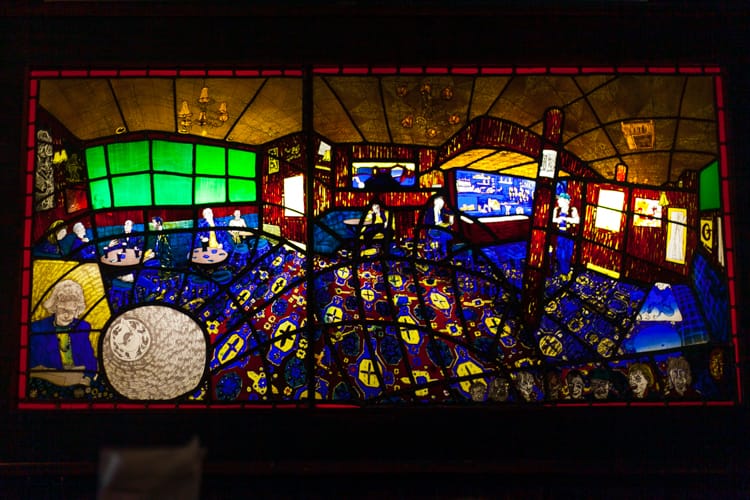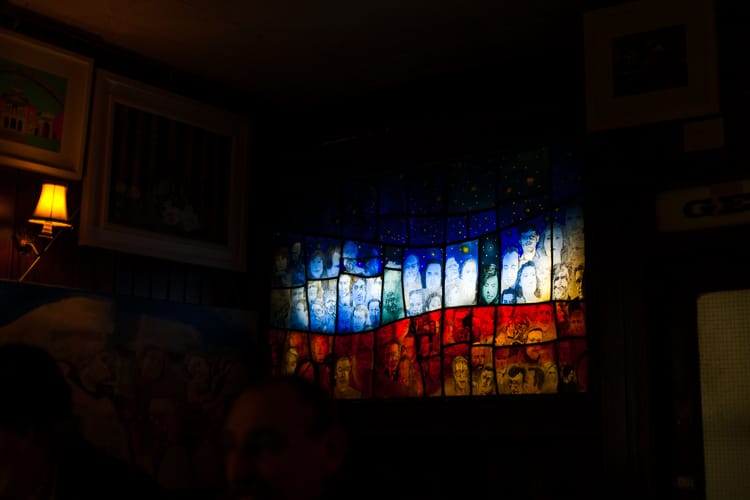What’s the best way to tell area residents about plans for a new asylum shelter nearby?
The government should tell communities directly about plans for new asylum shelters, some activists and politicians say.
In 1993, Tommy Smith decided to capture the many characters who passed through the doors of Grogan’s. He asked artist Katharine Lamb to create the first of two pieces for the pub’s walls.

Tommy Smith is sat with a cup of tea inside Grogan’s pub on South William Street.
The wall next to where he’s seated is given over to a large work of stained-glass. At the other end of the pub, a sister piece greets those who enter from Castle Market Street.
Smith has co-owned Grogan’s since 1973. He has seen its growth, known its charm and heard its bones rattle on many a busy Saturday night.
Above all else though, he’s known its regulars.
In 1993, Smith decided he wanted to capture the many characters who passed through the doors, and commissioned artist Katharine Lamb to create the first of two pieces for the pub’s walls.
Today, he refers to the subject matter of the two works as “the day people” and “the night people”.

Lamb has only recently graduated from the National College of Art and Design, she said, when Smith approached her about the first piece. Inspired by stained-glass artist Harry Clarke, she set about photographing the regulars seen in the first panel.
“I did an awful lot of research,” says Lamb. “Taking photographs, meeting people, looking at things that Tommy wanted to be in it.”
Stained glass is a medium rarely seen outside the larger galleries, and it’s complicated to make. For the first panel, with the day people, Lamb worked with a blue-and-red piece of smashed glass, staining it with oranges and yellows. She acid-etched off areas of colour, and painted figures on by firing paint to incorporate it into the glass.
At the pub, Smith stands up to point out the characters in Lamb’s first panel. He remembers each and every name: Therese Cronin, the cobbler Billy Delaney, the busker Alan Scotsman, the actor Donal McCann, and the painter Charles Brady, amongst others.
Smith wanted Donal McCann to feature, but the actor had no interest in having his photograph taken for the artist to work off. Lamb’s mother, actress Geraldine Plunkett, had starred with McCann in the play, Juno and the Paycock, so the image at the centre of the panel is taken from McCann’s stage perfomance at the Gate Theatre.
Smith himself made it into the first stained-glass panel, and is one of the few still surviving, he says.
Grogan’s has been a haven for creative types since Smith first took over, more than four decades ago. The majority of wall space is given over to the work of local artists, and each piece is for sale – the only exceptions being the stained-glass testimonials to the pub’s regulars.
The first panel took Lamb the guts of a year to create, and, soon after she completed it, Smith commissioned a second panel.

For the follow-up in 1995, a scene of a busy boozy evening, Lamb had far more characters to immortalise. She abandoned glass-painting, this time around.
“For the second panel, I actually screen-printed the images on,” she says. “The drawings were all done individually and then from that I photocopied them and played around with them.”
Painting directly onto glass can be a painstaking process. Screen-printing offers more leeway where corrections are concerned, Lamb says.
Back in the pub, Tommy Smith shows me down to the second panel, and, again, his memory holds up. Pointing out local characters, like plumber Jim Ward or bookmaker Paddy Kelly, Smith knows his clientele.
These are his night people, rowdier than the daytime regulars from the first panoramic panel.
The second panel is split between the red and yellow of the pub’s interior, leading up then to the nighttime blue and the stars above. Like the first panel, the work is lighted from behind to illuminate the faces sketched by Lamb.
Because of the different methods she used to render them, the night people, screen-printed onto the glass, are more detailed than the day people, painted on by hand.
Smith sits back down beside the South William Street entrance. He talks about the artwork currently for sale in the pub. A regular enters, and, of course, Smith knows his name.
He says that the staff often get requests or comments from the usual suspects to have themselves captured in stained glass. Yet, for Smith, two is enough.
And for Katharine Lamb, who still pops in occasionally, the works provided an early instance of intense artistic concentration. They were, she says, “a crazy thing to do” at the time.
But, for the many who pass through the doors at Grogan’s, they are a welcome addition.
Get our latest headlines in one of them, and recommendations for things to do in Dublin in the other.